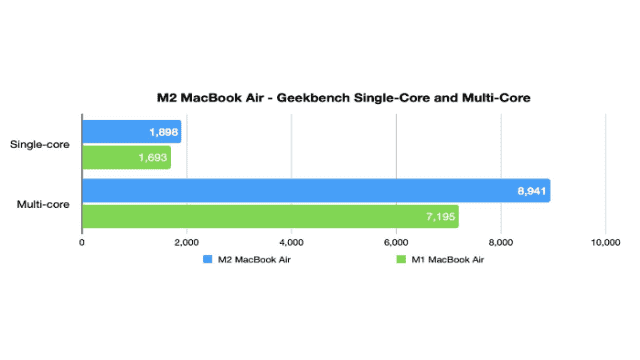Are you planning to purchase a new Mac M2, but can’t decide between the 8 core and 10 core versions? In addition, you may be wondering if it’s worth paying extra for a higher GPU. In this article, we’ll help you make an informed decision by examining the differences between the 8 core and 10 core versions and the importance of the GPU in your decision-making process.
8 Core vs 10 Core: What’s Different?
The only difference between the two models is GPU cores and SSD speed. It means they have the same CPU inside with 16-core Neural Engine, so we can expect the same CPU performance between the two.
Apple has increased the clock speed on the M2 model, so we should see an improvement in the single-core and multi-core performance despite both M2 models still having an 8-core CPU.
The M2 MacBook Air scored 1,898 in the single-core Geekbench 5 test and 8,941 in the multi-core version. This is a small improvement compared to the M1 chip in the first release.
Both machines are pretty even when it comes to Geekbench 5 test. The 512 GB model with a 10-core GPU scored 1,930 in the single-core test and 8,993 multi-core test. The 256GB model with an 8-core GPU scored 1,936 and 8,962 in the same tests.
Disk Speed Test
The 512 GB model with a 10-core GPU has a faster SSD than the base model with a 256 SSD and an 8-core GPU. You will get faster read and write speeds on the more expensive model.
We transferred 33GB of files from a Thunderbolt-enabled SSD drive to both MacBook Air models to see which one went out on top. The 512 GB model took about 14 seconds to complete the file transfer.
Meanwhile, the base model took up to 55 seconds to receive that same amount of data from a fast SSD drive. That was a considerable difference. However, 55 seconds is still acceptable.
In short, with the 512 GB model, you will get a faster SSD speed, but the difference is not significant as we expected. The base model is the better option for folks who do not usually do file transfers.
Video Export Test
Next up, we did a video export test using Final Cut Pro. During the test, we exported a 10-minute 4K clip to H.264 to see if the 512GB model with a faster SSD really made a difference.
Both machines were pretty close, with the higher-end model finishing the task in 5,4 seconds against 5,06 seconds recorded on the base model.
For the Final Cut Export ProRes test, the M2 Air with 10-core GPU took 3,25 seconds to export a 4K 10-minute clip, while the base model took 4,32 seconds. That was over a minute difference in export time.
GFX Benchmark
To put the two models to their limit, we decided to do a GFX benchmark test, a cool tool that tests your machine’s GPU performance.
We used the 4K Aztec Ruins High Tier Offscreen to test both machines.
The more expensive Air showed a slight improvement over the base model. On average, the M2 Air with a 10-core GPU got 48 frames per second, while the base model with an 8-core GPU got 39 fps.
Gaming
With the power of the Apple Silicon chip, Mac machines can now handle many graphically demanding games. We tested the gaming performance on both machines running Shadows of the Tomb Raider, which is optimized for macOS. The results surprised us.
The base model with an 8-core GPU scored a better frame rate when compared to the higher-end model. This might be due to the extra GPU cores on the higher-end model that throttled more, which resulted in a frame rate drop.
Should You Buy The 10-Core Model?
The short answer is No. The 10-core model does not show a significant change over the base model. You will still get the same design, amount of RAM, and display technology. The extra GPU cores made a small difference when exporting high-res videos or photos. The base model is even better if you are gaming, offering a more sustainable frame rate. Even though the higher-end model has more storage and a faster SSD, it’s not worth paying an extra $100.



